Spatiotemporal Patterns of Wolves, and Sympatric Predators and Prey Relative to Human Disturbance in Northwestern Greece
Abstract
1. Introduction
2. Materials and Methods
2.1. Study Area
2.2. Data collection: Camera Trapping
2.3. Data Analysis
2.3.1. Relative Abundance Index
2.3.2. Wolf Temporal Activity Patterns Relative to Other Mammals
2.3.3. Temporal Activity Patterns Relative to Human Disturbance
- XHigh is the percentage of the nocturnal detections of wild mammals at high human disturbance sites;
- XLow is the percentage of the nocturnal detections of wild mammals at low human disturbance sites.
2.3.4. Modeling Detection Rates of Mammals
3. Results
3.1. Wolf Activity Pattern Overlap with Other Mammals
3.2. Mammal Activity Patterns Overlap with Human Disturbance
3.3. Mammal Nocturnality Relative to Intensity of Human Disturbance
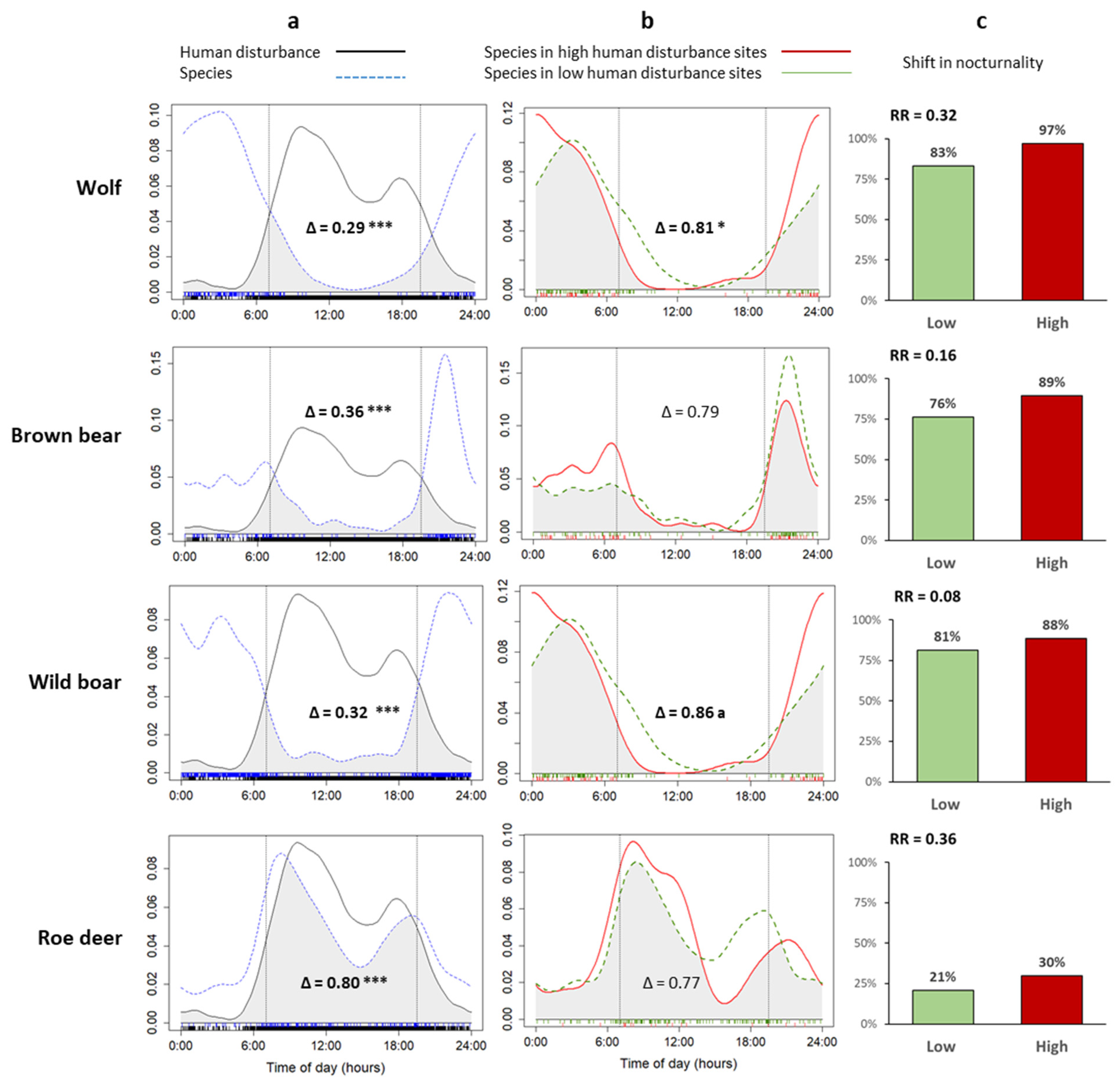
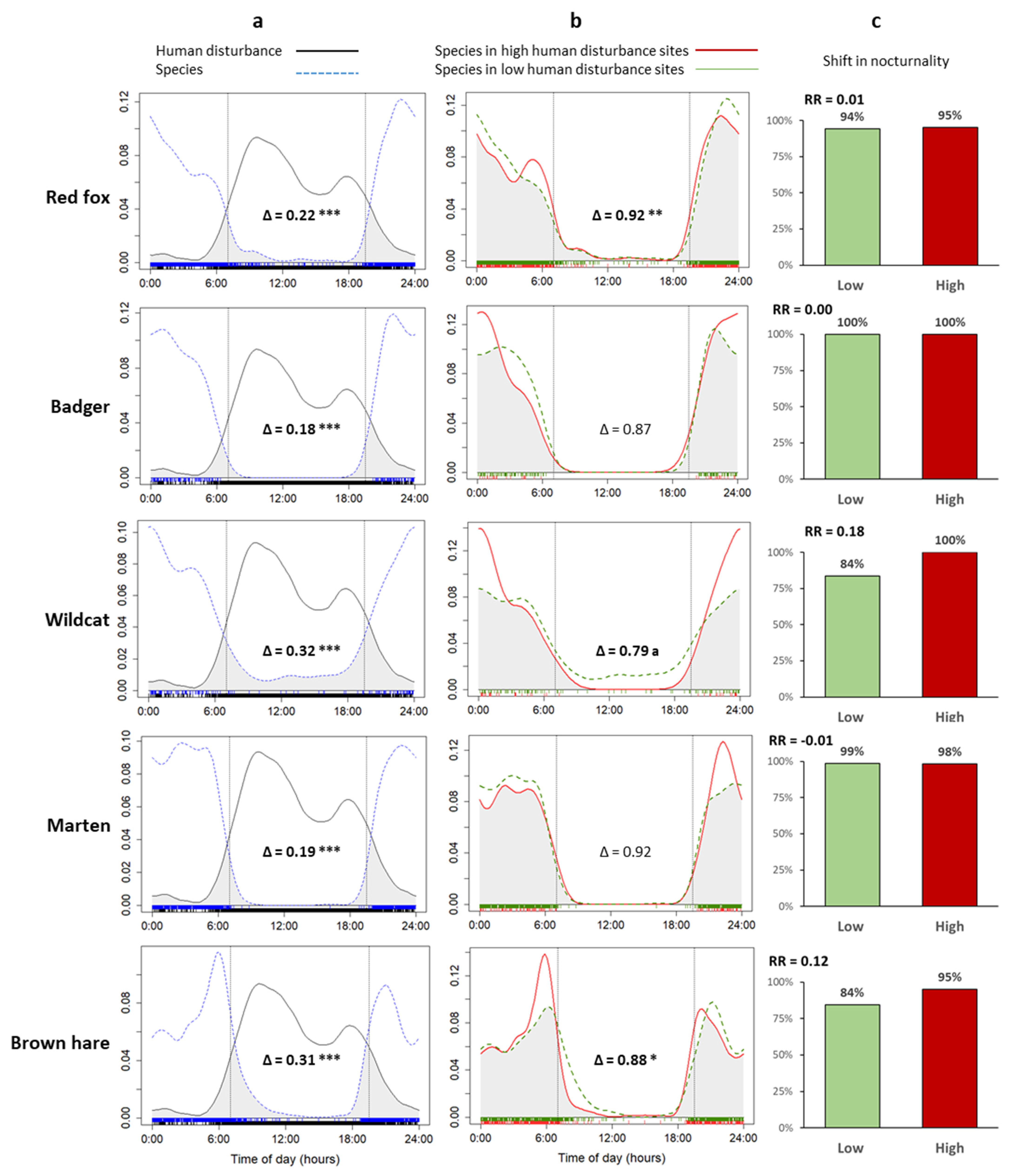
3.4. Factors Influencing Spatial Variation in Detection Rates of Wild Mammals
4. Discussion
4.1. Temporal Overlap between the Wolf, and Sympatric Predators and Prey
4.2. Temporal Anthropogenic Avoidance Patterns
4.3. Nocturnality Shift vs. Human Disturbance
4.4. Factors Affecting Spatial Detection Patterns of Wild Mammals
5. Implications for Wolf Conservation
Supplementary Materials
Author Contributions
Funding
Institutional Review Board Statement
Informed Consent Statement
Data Availability Statement
Acknowledgments
Conflicts of Interest
References
- Rovero, F.; Zimmermann, F. Camera Trapping for Wildlife Research; Pelagic Publishing Ltd.: London, UK, 2016. [Google Scholar]
- Gaynor, K.M.; Hojnowski, C.E.; Carter, N.H.; Brashares, J.S. The influence of human disturbance on wildlife nocturnality. Science 2018, 360, 1232–1235. [Google Scholar] [CrossRef] [PubMed]
- Kati, V.; Kassara, C.; Vassilakis, D.; Papaioannou, H. Balkan Chamois (Rupicapra rupicapra balcanica) Avoids Roads, Settlements, and Hunting Grounds: An Ecological Overview from Timfi Mountain, Greece. Diversity 2020, 12, 124. [Google Scholar] [CrossRef]
- Brivio, F.; Grignolio, S.; Brogi, R.; Benazzi, M.; Bertolucci, C.; Apollonio, M. An analysis of intrinsic and extrinsic factors affecting the activity of a nocturnal species: The wild boar. Mamm. Biol. 2017, 84, 73–81. [Google Scholar] [CrossRef]
- Torretta, E.; Serafini, M.; Imbert, C.; Milanesi, P.; Meriggi, A. Wolves and wild ungulates in the Ligurian Alps (Western Italy): Prey selection and spatial-temporal interactions. Mammalia 2017, 81, 537–551. [Google Scholar] [CrossRef]
- Rossa, M.; Lovari, S.; Ferretti, F. Spatiotemporal patterns of wolf, mesocarnivores and prey in a Mediterranean area. Behav. Ecol. Sociobiol. 2021, 75, 32. [Google Scholar] [CrossRef]
- Torretta, E.; Serafini, M.; Puopolo, F.; Schenone, L. Spatial and temporal adjustments allowing the coexistence among carnivores in Liguria (N-W Italy). Acta Ethol. 2016, 19, 123–132. [Google Scholar] [CrossRef]
- Theobald, D.M.; Kennedy, C.; Chen, B.; Oakleaf, J.; Baruch-Mordo, S.; Kiesecker, J. Earth transformed: Detailed mapping of global human modification from 1990 to 2017. Earth Syst. Sci. Data 2020, 12, 1953–1972. [Google Scholar] [CrossRef]
- Meijer, J.R.; Huijbregts, M.A.J.; Schotten, K.C.G.J.; Schipper, A.M. Global patterns of current and future road infrastructure. Environ. Res. Lett. 2018, 13, 64006. [Google Scholar] [CrossRef]
- Wolf, C.; Ripple, W.J. Range contractions of the world’s large carnivores. R. Soc. Open Sci. 2017, 4, 170052. [Google Scholar] [CrossRef]
- UNEP (United Nations Environment Programme). Kunming-Montreal Global Biodiversity Framework; Convention on Biological Diversity, CBD/COP/15/L.25; United Nations: New York, NY, USA, 2022. [Google Scholar]
- Clinchy, M.; Zanette, L.Y.; Roberts, D.; Suraci, J.P.; Buesching, C.D.; Newman, C.; Macdonald, D.W. Fear of the human “super predator” far exceeds the fear of large carnivores in a model mesocarnivore. Behav. Ecol. 2016, 27, 1826–1832. [Google Scholar] [CrossRef]
- Bonnot, N.C.; Couriot, O.; Berger, A.; Cagnacci, F.; Ciuti, S.; De Groeve, J.E.; Gehr, B.; Heurich, M.; Kjellander, P.; Kröschel, M.; et al. Fear of the dark? Contrasting impacts of humans versus lynx on diel activity of roe deer across Europe. J. Anim. Ecol. 2020, 89, 132–145. [Google Scholar] [CrossRef] [PubMed]
- Ciuti, S.; Northrup, J.M.; Muhly, T.B.; Simi, S.; Musiani, M.; Pitt, J.A.; Boyce, M.S. Effects of Humans on Behaviour of Wildlife Exceed Those of Natural Predators in a Landscape of Fear. PLoS ONE 2012, 7, e50611. [Google Scholar] [CrossRef] [PubMed]
- Cremonesi, G.; Bisi, F.; Gaffi, L.; Zaw, T.; Naing, H.; Moe, K.; Aung, Z.; Gagliardi, A.; Wauters, L.A.; Preatoni, D.G.; et al. Evaluation of Human Disturbance on the Activity of Medium–Large Mammals in Myanmar Tropical Forests. Forests 2021, 12, 290. [Google Scholar] [CrossRef]
- Oberosler, V.; Groff, C.; Iemma, A.; Pedrini, P.; Rovero, F. The influence of human disturbance on occupancy and activity patterns of mammals in the Italian Alps from systematic camera trapping. Mamm. Biol. 2017, 87, 50–61. [Google Scholar] [CrossRef]
- Ordiz, A.; Aronsson, M.; Persson, J.; Støen, O.-G.; Swenson, J.E.; Kindberg, J. Effects of Human Disturbance on Terrestrial Apex Predators. Diversity 2021, 13, 68. [Google Scholar] [CrossRef]
- Naidoo, R.; Burton, A.C. Relative effects of recreational activities on a temperate terrestrial wildlife assemblage. Conserv. Sci. Pract. 2020, 2, e271. [Google Scholar] [CrossRef]
- De Matos Dias, D.; de Campos, C.B.; Guimarães Rodrigues, F.H. Behavioural ecology in a predator-prey system. Mamm. Biol. 2018, 92, 30–36. [Google Scholar] [CrossRef]
- Theuerkauf, J.; Jȩdrzejewski, W.; Schmidt, K.; Okarma, H.; Ruczyński, I.; Śniezko, S.; Gula, R. Daily Patterns and Duration of Wolf Activity in the Białowieza Forest, Poland. J. Mammal. 2003, 84, 243–253. [Google Scholar] [CrossRef]
- Chapron, G.; Kaczensky, P.; Linnell, J.D.C.; von Arx, M.; Huber, D.; Andrén, H.; López-Bao, J.V.; Adamec, M.; Álvares, F.; Anders, O.; et al. Recovery of large carnivores in Europe’s modern human-dominated landscapes. Science 2014, 346, 1517–1519. [Google Scholar] [CrossRef]
- Iliopoulos, Y.; Petridou, M.; Astaras, C.; Sideri, E. Total deliverables for wolf monitoring. In Monitoring and Assessment of the Conservation Status of Species of Mammals of Community Interest in Greece; Prepared for the Hellenic Ministry of Environment; Papamichail, C., Arapis, T., Petkidis, K., Eds.; Ministry of the Environment and Energy: Athens, Greece, 2015. [Google Scholar]
- Linnell, J.D.; Cretois, B. Research for AGRI Committee—The Revival of Wolves and Other Large Predators and Its Impact on Farmers and Their Livelihood in Rural Regions of Europe; European Parliament: Strasbourg, France, 2018. [Google Scholar]
- CLC. Corine Land Cover. 2018. Available online: https://land.copernicus.eu/pan-european/corine-land-cover/clc2018 (accessed on 20 February 2022).
- ELSTAT (Hellenic Statistical Authority). Population Census Data. 2011. Available online: https://www.statistics.gr/el/statistics/pop (accessed on 15 October 2022).
- ELGA (Hellenic Agricultural Insurance Organization). Data on Single Livestock Breeding Declarations; ELGA: Athens, Greece, 2018. [Google Scholar]
- EEA. European Environment Agency Reference Grid. 2013. Available online: https://www.eea.europa.eu/data-and-maps/data/eea-reference-grids-2 (accessed on 20 February 2019).
- Beirne, C.; The Wildlife Coexistence Lab; UBC; WildCam Network. An Introduction to Camera Trap Data Management and Analysis in R. Online Book. 2022. Available online: https://bookdown.org/c_w_beirne/wildCo-Data-Analysis/ (accessed on 5 August 2022).
- Linkie, M.; Ridout, M.S. Assessing tiger–prey interactions in Sumatran rainforests. J. Zool. 2011, 284, 224–229. [Google Scholar] [CrossRef]
- O’Brien, T.G.; Kinnaird, M.F.; Wibisono, H.T. Crouching tigers, hidden prey: Sumatran tiger and prey populations in a tropical forest landscape. Anim. Conserv. 2003, 6, 131–139. [Google Scholar] [CrossRef]
- Meredith, M.; Ridout, M. R Package “Overlap”: Estimates of Coefficient of Overlapping for Animal Activity Patterns. 2022. Available online: https://cran.r-project.org/web/packages/overlap/overlap.pdf (accessed on 5 August 2022).
- Ridout, M.S.; Linkie, M. Estimating overlap of daily activity patterns from camera trap data. J. Agric. Biol. Environ. Stat. 2009, 14, 322–337. [Google Scholar] [CrossRef]
- Monterroso, P.; Alves, P.C.; Ferreras, P. Plasticity in circadian activity patterns of mesocarnivores in Southwestern Europe: Implications for species coexistence. Behav. Ecol. Sociobiol. 2014, 68, 1403–1417. [Google Scholar] [CrossRef]
- Mori, E.; Bagnato, S.; Serroni, P.; Sangiuliano, A.; Rotondaro, F.; Marchianò, V.; Cascini, V.; Poerio, L.; Ferretti, F. Spatiotemporal mechanisms of coexistence in an European mammal community in a protected area of southern Italy. J. Zool. 2020, 310, 232–245. [Google Scholar] [CrossRef]
- Agostinelli, C.; Lund, U. R Package ‘Circular’: Circular Statistics (Version 0.4-95). 2022. Available online: https://r-forge.r-project.org/projects/circular/ (accessed on 25 August 2022).
- Aurich-Rodriguez, F.; Piana, R.P.; Appleton, R.D.; Burton, A.C. Threatened Andean bears are negatively affected by human disturbance and free-ranging cattle in a protected area in northwest Peru. Mamm. Biol. 2022, 102, 177–187. [Google Scholar] [CrossRef]
- Lovell, C.; Li, S.; Turner, J.; Carbone, C. The effect of habitat and human disturbance on the spatiotemporal activity of two urban carnivores: The results of an intensive camera trap study. Ecol. Evol. 2022, 12, e8746. [Google Scholar] [CrossRef] [PubMed]
- Sollmann, R. A gentle introduction to camera-trap data analysis. Afr. J. Ecol. 2018, 56, 740–749. [Google Scholar] [CrossRef]
- ESRI. ArcGIS Pro; Release 3.0.1; Environmental Systems Research Institute: Redlands, CA, USA, 2022. [Google Scholar]
- Rehman, E.U.; Din, J.U.; Ahmad, S.; Hameed, S.; Shah, K.A.; Mehmood, T.; Nawaz, M.A. Insight into occupancy determinants and conflict dynamics of grey wolf (Canis lupus) in the dry temperate zone of Hindukush Range. Glob. Ecol. Conserv. 2021, 25, e01402. [Google Scholar] [CrossRef]
- Gelman, A. Scaling regression inputs by dividing by two standard deviations. Stat. Med. 2008, 27, 2865–2873. [Google Scholar] [CrossRef]
- Peduzzi, P.; Concato, J.; Kemper, E.; Holford, T.R.; Feinstein, A.R. A simulation study of the number of events per variable in logistic regression analysis. J. Clin. Epidemiol. 1996, 49, 1373–1379. [Google Scholar] [CrossRef]
- Tibshirani, R. Regression Shrinkage and Selection Via the Lasso. J. R. Stat. Soc. Ser. B Stat. Methodol. 1996, 58, 267–288. [Google Scholar] [CrossRef]
- Friedman, J.; Hastie, T.; Tibshirani, R. Regularization Paths for Generalized Linear Models via Coordinate Descent. J. Stat. Softw. 2010, 33, 1–22. [Google Scholar] [CrossRef] [PubMed]
- Zuur, A.; Ieno, E.N.; Walker, N.; Saveliev, A.A.; Smith, G.M. Mixed Effects Models and Extensions in Ecology with R; Springer: New York, NY, USA, 2009; Volume 574. [Google Scholar]
- Burnham, K.P.; Anderson, D.R. Model Selection and Multimodel Inference: A Practical Information-Theoretic Approach, 2nd ed.; Springer: New York, NY, USA, 2002. [Google Scholar]
- Barton, K. MuMIn: Multi-Model Inference. R Package Version 1.46.0. 2022. Available online: https://CRAN.R-project.org/package=MuMIn (accessed on 10 September 2022).
- Newsome, T.M.; Boitani, L.; Chapron, G.; Ciucci, P.; Dickman, C.R.; Dellinger, J.A.; López-Bao, J.V.; Peterson, R.O.; Shores, C.R.; Wirsing, A.J.; et al. Food habits of the world’s grey wolves. Mamm. Rev. 2016, 46, 255–269. [Google Scholar] [CrossRef]
- Massei, G.; Kindberg, J.; Licoppe, A.; Gačić, D.; Šprem, N.; Kamler, J.; Baubet, E.; Hohmann, U.; Monaco, A.; Ozoliņš, J.; et al. Wild boar populations up, numbers of hunters down? A review of trends and implications for Europe. Pest Manag. Sci. 2015, 71, 492–500. [Google Scholar] [CrossRef] [PubMed]
- Tsaparis, D.; Sotiropoulos, K.; Legakis, A.; Kotoulas, G.; Kasapidis, P. New phylogeographic insights support the distinctiveness and conservation value of the little-known Greek roe deer populations. Mamm. Biol. 2019, 96, 23–27. [Google Scholar] [CrossRef]
- Capitani, C.; Chynoweth, M.; Kusak, J.; Çoban, E.; Şekercioğlu Çağan, H. Wolf diet in an agricultural landscape of north-eastern Turkey. Mammalia 2016, 80, 329. [Google Scholar] [CrossRef]
- Petridou, M.; Youlatos, D.; Lazarou, Y.; Selinides, K.; Pylidis, C.; Giannakopoulos, A.; Kati, V.; Iliopoulos, Y. Wolf diet and livestock selection in central Greece. Mammalia 2019, 83, 530. [Google Scholar] [CrossRef]
- Ciucci, P.; Artoni, L.; Crispino, F.; Tosoni, E.; Boitani, L. Inter-pack, seasonal and annual variation in prey consumed by wolves in Pollino National Park, southern Italy. Eur. J. Wildl. Res. 2018, 64, 5. [Google Scholar] [CrossRef]
- Martins, I.; Krofel, M.; Mota, P.G.; Álvares, F. Consumption of Carnivores by Wolves: A Worldwide Analysis of Patterns and Drivers. Diversity 2020, 12, 470. [Google Scholar] [CrossRef]
- Ordiz, A.; Milleret, C.; Uzal, A.; Zimmermann, B.; Wabakken, P.; Wikenros, C.; Sand, H.; Swenson, J.E.; Kindberg, J. Individual Variation in Predatory Behavior, Scavenging and Seasonal Prey Availability as Potential Drivers of Coexistence between Wolves and Bears. Diversity 2020, 12, 356. [Google Scholar] [CrossRef]
- Ciucci, P.; Boitani, L.; Francisci, F.; Andreoli, G. Home range, activity and movements of a wolf pack in central Italy. J. Zool. 1997, 243, 803–819. [Google Scholar] [CrossRef]
- Kusak, J.; Skrbinšek, A.M.; Huber, D. Home ranges, movements, and activity of wolves (Canis lupus) in the Dalmatian part of Dinarids, Croatia. Eur. J. Wildl. Res. 2005, 51, 254–262. [Google Scholar] [CrossRef]
- Frey, S.; Tejero, D.; Baillie-David, K.; Burton, A.C.; Fisher, J.T. Predator control alters wolf interactions with prey and competitor species over the diel cycle. Oikos 2022, 2022, e08821. [Google Scholar] [CrossRef]
- Theuerkauf, J. What Drives Wolves: Fear or Hunger? Humans, Diet, Climate and Wolf Activity Patterns. Ethology 2009, 115, 649–657. [Google Scholar] [CrossRef]
- Ordiz, A.; Kindberg, J.; Sæbø, S.; Swenson, J.E.; Støen, O.-G. Brown bear circadian behavior reveals human environmental encroachment. Biol. Conserv. 2014, 173, 1–9. [Google Scholar] [CrossRef]
- Lazzeri, L.; Fazzi, P.; Lucchesi, M.; Mori, E.; Velli, E.; Cappai, N.; Ciuti, F.; Ferretti, F.; Fonda, F.; Paniccia, C.; et al. The rhythm of the night: Patterns of activity of the European wildcat in the Italian peninsula. Mamm. Biol. 2022, 102, 1–14. [Google Scholar] [CrossRef]
- Gilbert, N.A.; McGinn, K.A.; Nunes, L.A.; Shipley, A.A.; Bernath-Plaisted, J.; Clare, J.D.J.; Murphy, P.W.; Keyser, S.R.; Thompson, K.L.; Maresh Nelson, S.B.; et al. Daily activity timing in the Anthropocene. Trends Ecol. Evol. 2022; in press. [Google Scholar]
- Frey, S.; Volpe, J.P.; Heim, N.A.; Paczkowski, J.; Fisher, J.T. Move to nocturnality not a universal trend in carnivore species on disturbed landscapes. Oikos 2020, 129, 1128–1140. [Google Scholar] [CrossRef]
- Podgórski, T.; Baś, G.; Jędrzejewska, B.; Sönnichsen, L.; Śnieżko, S.; Jędrzejewski, W.; Okarma, H. Spatiotemporal behavioral plasticity of wild boar (Sus scrofa) under contrasting conditions of human pressure: Primeval forest and metropolitan area. J. Mammal. 2013, 94, 109–119. [Google Scholar] [CrossRef]
- Anile, S.; Devillard, S.; Nielsen, C.K.; Valvo, M.L. Anthropogenic threats drive spatio-temporal responses of wildcat on Mt. Etna. Eur. J. Wildl. Res. 2021, 67, 50. [Google Scholar] [CrossRef]
- Gaudry, W.; Saïd, S.; Gaillard, J.-M.; Chevrier, T.; Loison, A.; Maillard, D.; Bonenfant, C. Partial migration or just habitat selection? Seasonal movements of roe deer in an Alpine population. J. Mammal. 2015, 96, 502–510. [Google Scholar] [CrossRef]
- Mancinelli, S.; Falco, M.; Boitani, L.; Ciucci, P. Social, behavioural and temporal components of wolf (Canis lupus) responses to anthropogenic landscape features in the central Apennines, Italy. J. Zool. 2019, 309, 114–124. [Google Scholar] [CrossRef]
- Ares-Pereira, G.; Rosalino, L.M.; Teixeira, D.; Castro, G.; Magalhães, A.; Lima, C.; Fonseca, C.; Torres, R.T. Eucalyptus plantations alter spatiotemporal relationships of wild ungulates. Agric. Ecosyst. Environ. 2022, 340, 108174. [Google Scholar] [CrossRef]
- Fernández, N.; Selva, N.; Yuste, C.; Okarma, H.; Jakubiec, Z. Brown bears at the edge: Modeling habitat constrains at the periphery of the Carpathian population. Biol. Conserv. 2012, 153, 134–142. [Google Scholar] [CrossRef]
- Rutten, A.; Casaer, J.; Strubbe, D.; Leirs, H. Agricultural and landscape factors related to increasing wild boar agricultural damage in a highly anthropogenic landscape. Wildl. Biol. 2020, 2020, wlb.00634. [Google Scholar] [CrossRef]
- Smith, A.F.; Ciuti, S.; Shamovich, D.; Fenchuk, V.; Zimmermann, B.; Heurich, M. Quiet islands in a world of fear: Wolves seek core zones of protected areas to escape human disturbance. Biol. Conserv. 2022, 276, 109811. [Google Scholar] [CrossRef]
- Bonnot, N.; Morellet, N.; Verheyden, H.; Cargnelutti, B.; Lourtet, B.; Klein, F.; Hewison, A.J.M. Habitat use under predation risk: Hunting, roads and human dwellings influence the spatial behaviour of roe deer. Eur. J. Wildl. Res. 2013, 59, 185–193. [Google Scholar] [CrossRef]
- Liu, M.; Wang, Y.; Xia, F.; Bu, H.; Liu, Y.; Shen, X.; Li, S. Free-ranging livestock altered the spatiotemporal behavior of the endangered North Chinese leopard (Panthera pardus japonensis) and its prey and intensified human–leopard conflicts. Integr. Zool. 2022, 18, 143–156. [Google Scholar] [CrossRef]
- Zini, V.; Wäber, K.; Hornigold, K.; Lake, I.; Dolman, P.M. Human and environmental associates of local species-specific abundance in a multi-species deer assemblage. Eur. J. Wildl. Res. 2021, 67, 99. [Google Scholar] [CrossRef]
- Gompper, M.E. Adding Nuance to Our Understanding of Dog–Wildlife Interactions and the Need for Management. Integr. Comp. Biol. 2021, 61, 93–102. [Google Scholar]
- Young, J.K.; Olson, K.A.; Reading, R.P.; Amgalanbaatar, S.; Berger, J. Is Wildlife Going to the Dogs? Impacts of Feral and Free-roaming Dogs on Wildlife Populations. Bioscience 2011, 61, 125–132. [Google Scholar] [CrossRef]
- Skuban, M.; Find’o, S.; Kajba, M. Bears napping nearby: Daybed selection by brown bears (Ursus arctos) in a human-dominated landscape. Can. J. Zool. 2018, 96, 1–11. [Google Scholar] [CrossRef]
- Jahren, T.; Odden, M.; Linnell, J.D.C.; Panzacchi, M. The impact of human land use and landscape productivity on population dynamics of red fox in southeastern Norway. Mammal Res. 2020, 65, 503–516. [Google Scholar] [CrossRef]
- Meriggi, A.; Brangi, A.; Schenone, L.; Signorelli, D.; Milanesi, P. Changes of wolf (Canis lupus) diet in Italy in relation to the increase of wild ungulate abundance. Ethol. Ecol. Evol. 2011, 23, 195–210. [Google Scholar] [CrossRef]
- Imbert, C.; Caniglia, R.; Fabbri, E.; Milanesi, P.; Randi, E.; Serafini, M.; Torretta, E.; Meriggi, A. Why do wolves eat livestock? Factors influencing wolf diet in northern Italy. Biol. Conserv. 2016, 195, 156–168. [Google Scholar] [CrossRef]
- EC. EU Biodiversity Strategy for 2030 Bringing Nature Back into Our Lives; Communication from the Commission to the European Parliament, the Council, the European Economic and Social Committee and the Committee of the Regions, 20.5.2020.COM (2020) 380 Final; European Commission: Brussels, Belgium, 2020. [Google Scholar]
- EC. Commission Staff Working Document: Criteria and Guidance for Protected Areas Designations; SWD (2022) 23 Final; European Commission: Brussels, Belgium, 2022; p. 27. [Google Scholar]
- Kati, V.; Kassara, C.; Psaralexi, M.; Tzortzakaki, O.; Petridou, M.; Galani, A.; Hoffmann, M.T. Conservation policy under a roadless perspective: Minimizing fragmentation in Greece. Biol. Conserv. 2020, 252, 108828. [Google Scholar] [CrossRef]
- Iliopoulos, Y.; Youlatos, D.; Sgardelis, S. Wolf pack rendezvous site selection in Greece is mainly affected by anthropogenic landscape features. Eur. J. Wildl. Res. 2014, 60, 23–34. [Google Scholar] [CrossRef]
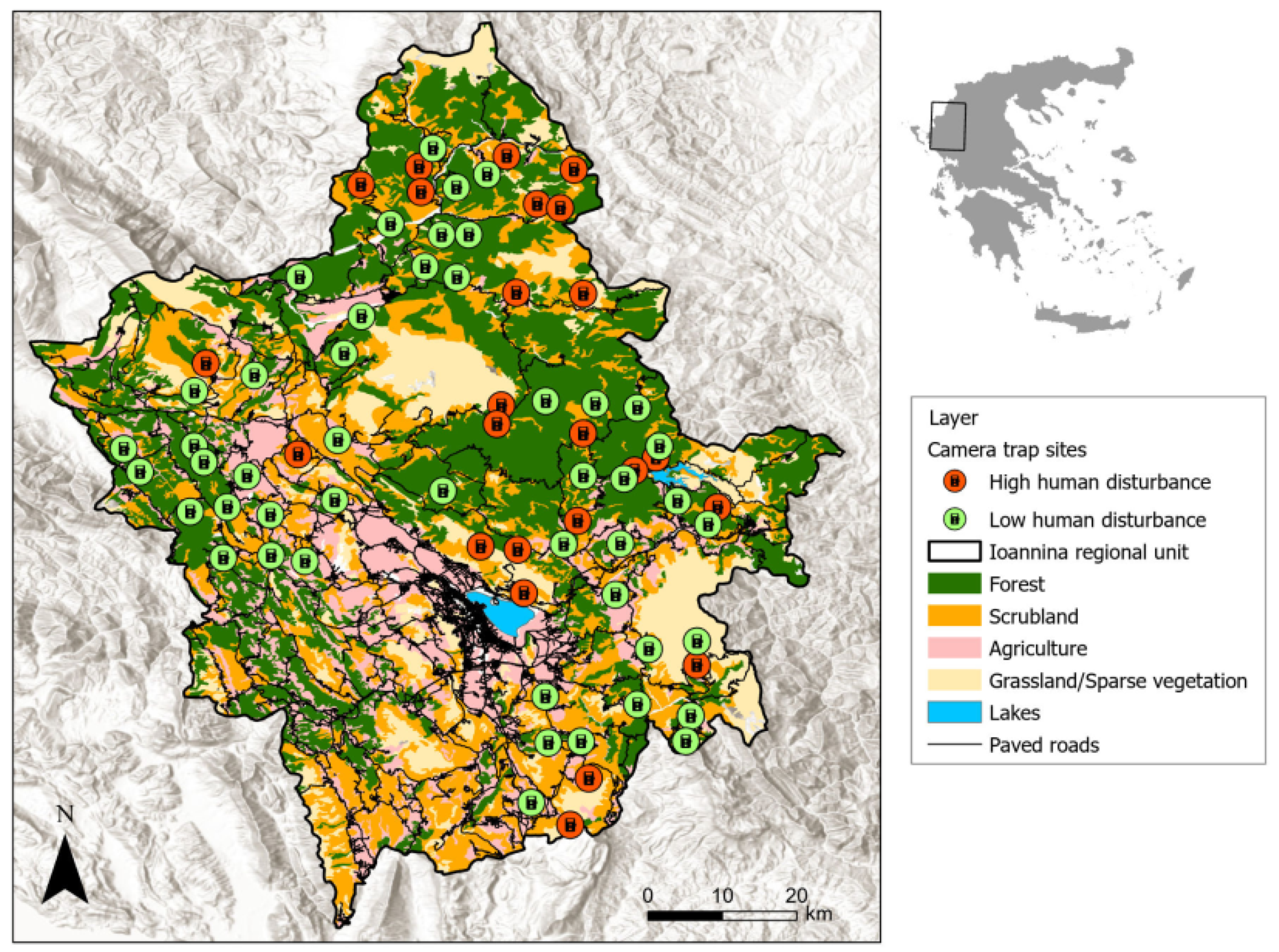
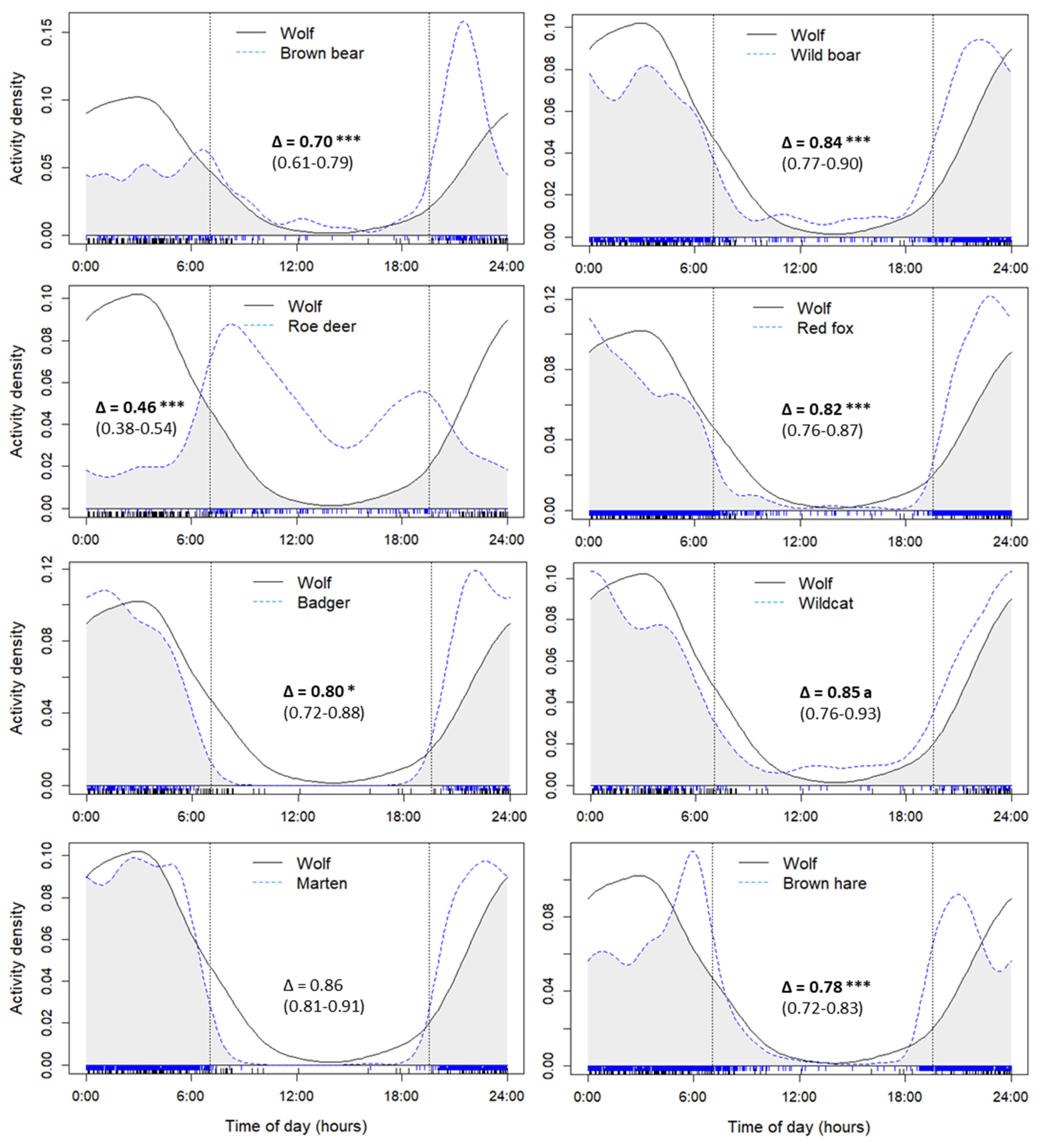
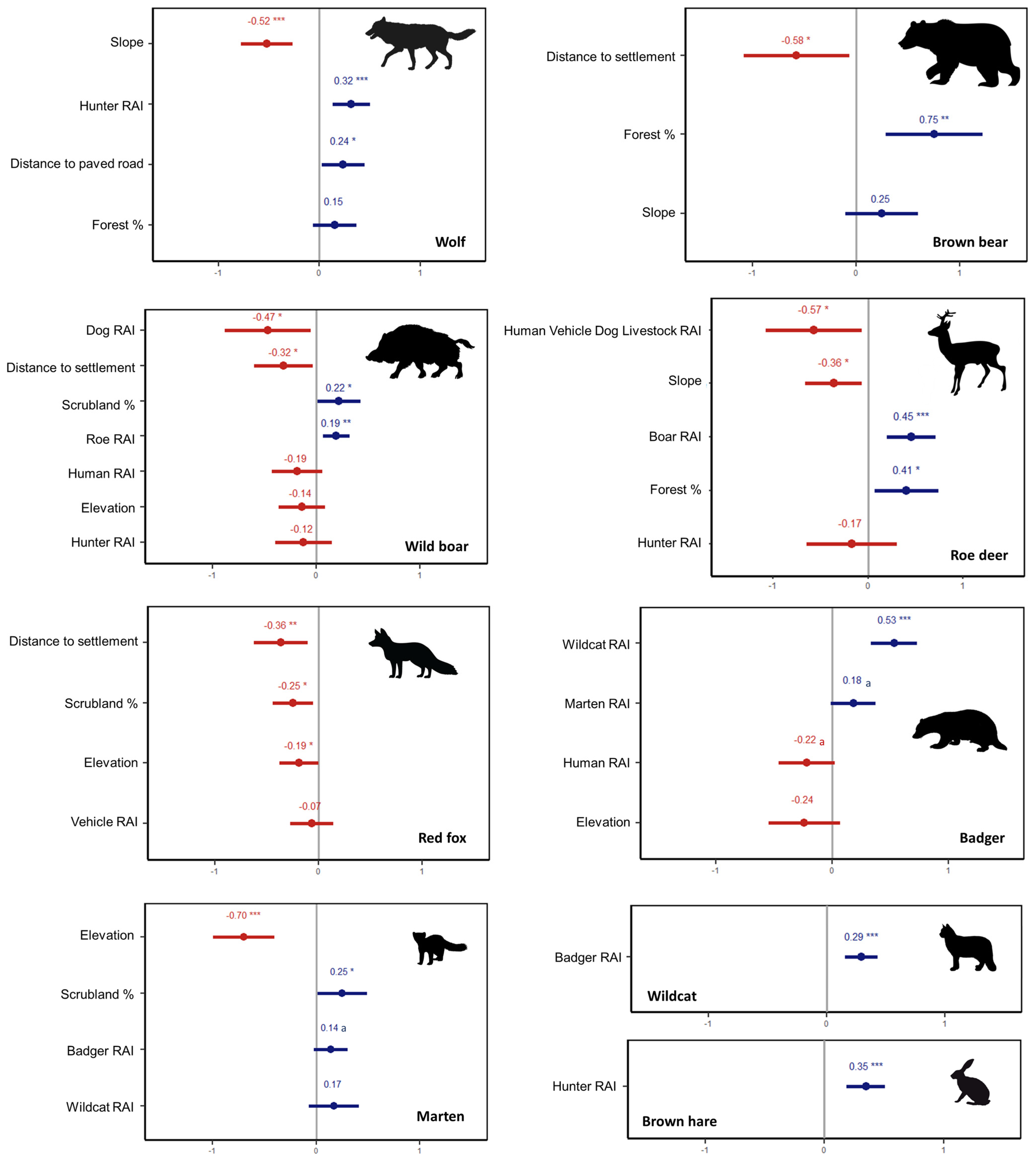
| Species | Detections | RAI | % Sites | |
|---|---|---|---|---|
| Wild mammals | ||||
| Grey wolf | Canis lupus | 168 | 6.31 | 79% |
| Brown bear | Ursus arctos | 150 | 5.63 | 52% |
| Wild boar | Sus scrofa | 598 | 22.52 | 94% |
| Roe deer | Capreolus capreolus | 159 | 6.04 | 62% |
| Red fox | Vulpes vulpes | 1937 | 72.90 | 96% |
| Badger | Meles meles | 174 | 6.49 | 68% |
| Wildcat | Felis silvestris | 135 | 5.07 | 59% |
| Stone marten | Martes foina | 786 | 29.47 | 86% |
| Brown hare | Lepus europaeus | 1064 | 39.83 | 82% |
| Hedgehog | Erinaceus sp. | 70 | 2.63 | 38% |
| Red squirrel | Sciurus vulgaris | 43 | 1.61 | 27% |
| Weasel | Mustela nivalis | 6 | 0.23 | 6% |
| Golden jackal | Canis aureus | 3 | 0.11 | 3% |
| Balkan chamois | Rupicapra rupicaprabalcanica | 1 | 0.04 | 1% |
| Human disturbance | ||||
| Human (non-motorized) | 645 | 24.21 | 87% | |
| Hunter | 169 | 6.34 | 45% | |
| Shepherd | 207 | 7.77 | 39% | |
| Tourist | 210 | 7.88 | 37% | |
| Resident | 66 | 2.48 | 34% | |
| Vehicle | 2181 | 81.87 | 89% | |
| Dog | 727 | 27.29 | 86% | |
| Livestock-guarding dog (LGD) | 437 | 16.40 | 56% | |
| Hunting dog | 246 | 9.23 | 58% | |
| Pet dog | 36 | 1.35 | 10% | |
| Village/Stray dog | 17 | 0.64 | 8% | |
| Livestock | 498 | 18.69 | 54% | |
| Cattle | 398 | 14.94 | 34% | |
| Sheep/goat | 71 | 2.67 | 25% | |
| Horse/mule | 33 | 1.24 | 11% | |
| Total human disturbance (Human + Vehicle + Dog + Livestock) | 3379 | 126.84 | 100% | |
Disclaimer/Publisher’s Note: The statements, opinions and data contained in all publications are solely those of the individual author(s) and contributor(s) and not of MDPI and/or the editor(s). MDPI and/or the editor(s) disclaim responsibility for any injury to people or property resulting from any ideas, methods, instructions or products referred to in the content. |
© 2023 by the authors. Licensee MDPI, Basel, Switzerland. This article is an open access article distributed under the terms and conditions of the Creative Commons Attribution (CC BY) license (https://creativecommons.org/licenses/by/4.0/).
Share and Cite
Petridou, M.; Benson, J.F.; Gimenez, O.; Kati, V. Spatiotemporal Patterns of Wolves, and Sympatric Predators and Prey Relative to Human Disturbance in Northwestern Greece. Diversity 2023, 15, 184. https://doi.org/10.3390/d15020184
Petridou M, Benson JF, Gimenez O, Kati V. Spatiotemporal Patterns of Wolves, and Sympatric Predators and Prey Relative to Human Disturbance in Northwestern Greece. Diversity. 2023; 15(2):184. https://doi.org/10.3390/d15020184
Chicago/Turabian StylePetridou, Maria, John F. Benson, Olivier Gimenez, and Vassiliki Kati. 2023. "Spatiotemporal Patterns of Wolves, and Sympatric Predators and Prey Relative to Human Disturbance in Northwestern Greece" Diversity 15, no. 2: 184. https://doi.org/10.3390/d15020184
APA StylePetridou, M., Benson, J. F., Gimenez, O., & Kati, V. (2023). Spatiotemporal Patterns of Wolves, and Sympatric Predators and Prey Relative to Human Disturbance in Northwestern Greece. Diversity, 15(2), 184. https://doi.org/10.3390/d15020184







